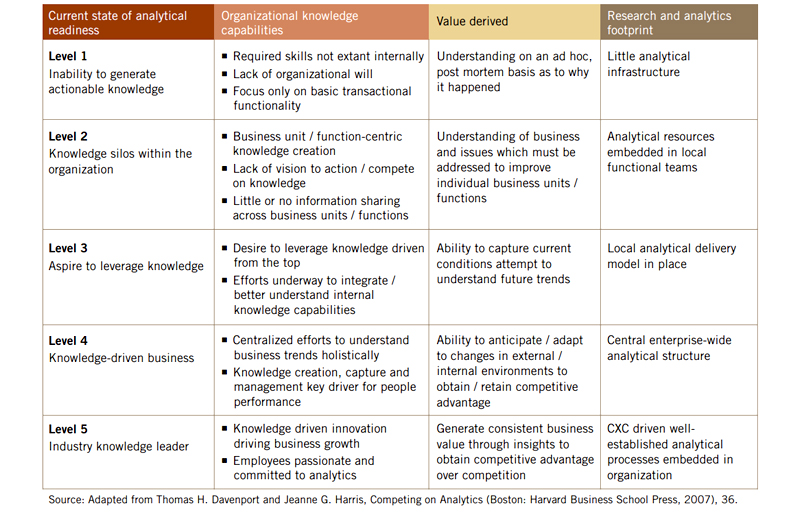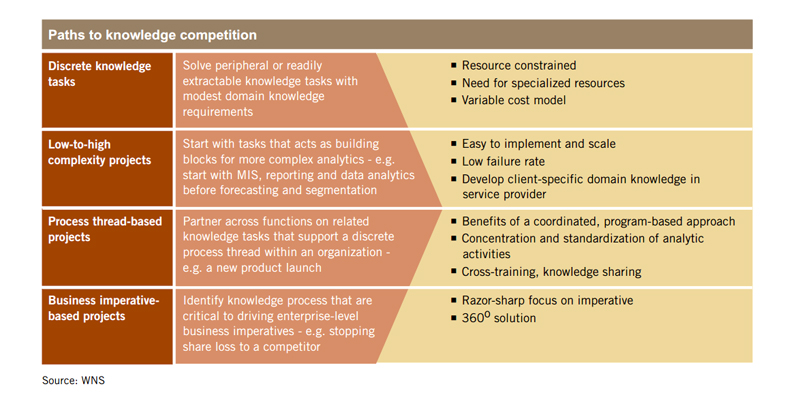The advantages of implementing knowledge process outsourcing (KPO) vary according to the aspiration of the organization. If a company already drives its decisions with knowledge, KPO can help more efficiently and cost effectively retain competitive advantage. If the organization wants to move up the knowledge competition scale, KPO can help more rapidly achieve the end-state. KPO has a role to play in every company – knowledge-novice or knowledge-savvy, regardless of the industry. But how an organization engages KPO depends on where it falls in the five levels of knowledge competition, as illustrated in the following exhibit.

The graphic below highlights the four starting points from which companies can embark on the road to knowledge competition, depending on their level of sophistication and the type of market challenges they face.

Level 1 and 2 companies, those which sit relatively low on the analytical savviness scale, will generally be best served beginning KPO implementation with discrete analytic tasks. The goal for these organizations is to pick the “low hanging fruit of the knowledge tree”, commencing with a low-risk, readily extractable analytic task. Because these companies are just embarking on the road to competing with knowledge, starting with a task that is not overly complex and does not require much domain knowledge will increase the likelihood of a successful outcome.
At these levels, organizations should focus on insights that can be developed without the allocation of many resources, generally without specialized resources, and developed under a variable cost model. Of course, just like exercise, even modest focus will pay rich dividends. Better responses from marketing programs, reduced fraud and better forecasting all have hard dollar benefits. Perhaps more importantly, this is an opportunity to invest in a proof of concept to validate to internal and external stakeholders that knowledge-driven decision making can take competitive positioning to the next level
For Level 3 organizations, those which already conduct more complex, integrated analytics processes, outsourcing as a proof of concept is still important and stakeholders will be closely monitoring the speed of completion and the quality of deliverables. This suggests the right place to begin outsourcing knowledge processes is to start with less complex tasks that support broader analytical capabilities. For example, it may be appropriate to commence sourcing more investigative forms of knowledge creation such as MIS, reporting and data analytics. Processes that form the basic knowledge building blocks inside the organization will help the sourcing partner build domain expertise unique to the company. If there are pain points and bottlenecks in these processes, the sourcing partner's process skills can remove them. Outsourcing these types of processes also frees up internal analytical talent from more mundane tasks, and enables them to focus on more strategic issues. Naturally, with the right sourcing, productivity and cost efficiencies will be achieved. As decisions are increasingly driven by actionable insights, moving up the complexity chain – to processes such as forecasting and segmentation – becomes the logical and anticipated next step
Initial projects should be easy to implement and scale, and designed with low potential for failure. Then ramping up the complexity fosters a strong relationship with the KPO provider, giving them the opportunity to develop the company-specific domain knowledge that is critical to success as the projects become more complex. Levels 1, 2 and 3 engagements gain most traction when they are initially focused on a business challenge. If the problem to be solved is loss of market share or improvement of overall customer experience by some factor, the analytic solution will resonate more strongly with stakeholders.
To underscore the benefits of KPO, consider what WNS's team delivered to a leading consumer product goods company seeking to become a knowledge competitor
Level 4 and 5 companies, those which are already analytically savvy, also benefit from implementing KPO as they use it to augment their own resources and leverage the global delivery footprint of their outsourcing partners.
As at the other levels, the organization gets all the benefits of outsourcing – refocus of internal talent, efficiencies, etc. The additional benefit KPO uniquely delivers to such companies is the ability to standardize knowledge processes and make them scalable. In these cases, remaining cutting edge in core areas of expertise is the driver to leverage the KPO delivery model. Quality with speed, flexibility and lower cost are key benefits.
How should Level 4 and 5 companies get started on a KPO program? These organizations have well developed knowledge processes, particularly in pockets supporting high-impact decisions. Good examples are pricing analytics, supply chain analytics, forecasting and fraud. Another way is to organize the program around top-of-mind business objectives driving the senior management team. For example, processes and tasks supporting a drive to cut distribution costs – supply/demand optimization, fleet utilization, forecasting, store lifecycle management, etc. – are well linked and can be supported with a highly specialized skill pool.
Whatever the scope of the KPO engagement, it should set the organization on the path to competing with knowledge – or moving up the knowledge savviness scale. KPO is simply an extension of the company's enterprise, allowing a large complex organization to consistently make smarter, better decisions.